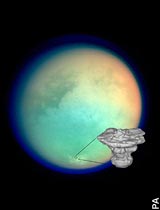
Images of the Saturn moon - Titan - show meandering river channels, icy cobbles, dark ovals suggestive of lakes and massive cumulus clouds that form in a similar way to tropical clouds on Earth.
Although Titan has an atmosphere that is tantalisingly similar to that of primordial Earth, its atmosphere is 10 times thicker and much cooler at -179C, so that it takes 29.5 Earth years for the atmosphere to respond to the seasons! Titan is also smaller and lacks oceans, which are central to Earth's climate. As a result, its weather is quite alien to ours.
Methane rain falls on the surface. The strongest storms occur when methane humidity in the middle atmosphere tops 80 per cent, producing updraughts as fast as 45mph that create thick clouds. Large hydrocarbon raindrops then fall, delivering up to 250lb of liquid on each square yard of Titan's surface, around 3in per hour, carving out its rugged features.
Scientists reported the first widespread evidence of giant hydrocarbon lakes near Titan's frigid north pole after Cassini, flew within 590 miles of the moon. Researchers counted about a dozen lakes six to 62 miles wide. Some were connected by channels and others had tributaries. Several were dried up; the ones that contained liquid were most likely a mixture of methane and ethane.
Titan's atmosphere is mostly nitrogen with a dash of methane and an intriguing batch of "organic molecules" that are vital to life. Although that does not mean that Titan supports life, it is viewed by some astrobiologists as a place that might be much like early Earth and therefore could yield clues about how life forms.
No comments:
Post a Comment